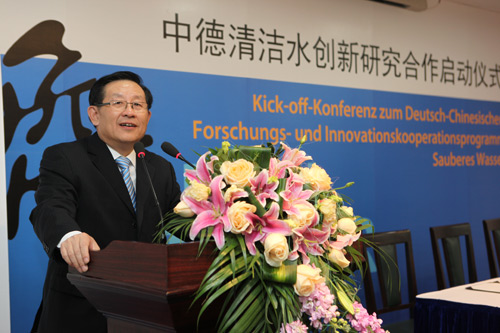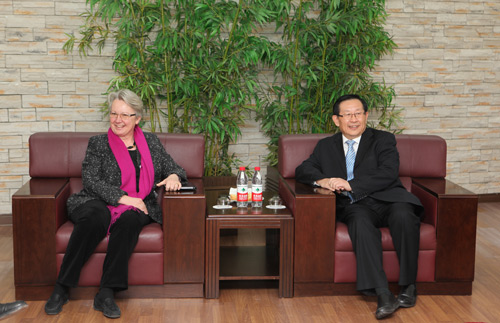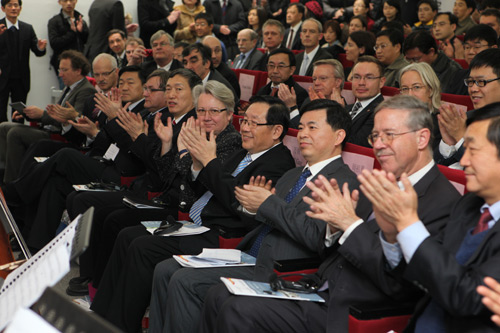CHINA SCIENCE AND TECHNOLOGY
NEWSLETTER
The Ministry of Science and Technology
People's Republic of China
|
|
|
N0.644 |
January 30, 2012 |
|
|
|
|
|
|
|
|
IN THIS ISSUE
|
|
*Six National Capacity Building Programs for Talents
*Five Regional Overseas Talents Recruitment Initiatives
*China-Germany Clean Water Collaboration
*Giant Panda’s "Love Rhetoric"
*China's First Low-Speed Maglev Train
* China's First Proprietary Petaflop Computer into Application
* First Chinese Voice-Interactive Software
* 7 Chinese Won First International Early Career Award
|
Six National Capacity Building Programs for Talents
According to a plan recently released by the State Administration of Foreign Experts Affairs to import more overseas talents during the 12th Five-year period (2011-2015), China will absorb more overseas high-caliber talents with versatile skills and knowing international norms, and open up a fast lane to nurture talented people through overseas training.
The Plan says during the 11th Five-year period (2006-2010), China has sent some 257,000 people to study or be trained abroad, through a range of training programs, and achieved fruitful results in enhancing the capacity building of its talents contingents.
During the 12th Five-year period, China will work on six capacity building programs aiming at enhancing China’s talents contingent, including annually sending 1,000 intermediate or senior level cadres and outstanding young and middle aged cadres to be trained overseas, through a party and government official training program; 1,000 senior corporate management personnel be trained abroad through a senior corporate management training program; 3,000 professionals and engineers and 200 university presidents be trained overseas, through a professional training program; 1,000 highly skilled technicians be trained overseas through a highly skilled personnel training program; 1,000 agricultural technology diffusion personnel and agricultural technicians be trained overseas through a training program dedicated to the agricultural sector; and 1,000 senior social workers be trained overseas through a training program initiated for the purpose.
Five Regional Overseas Talents Recruitment Initiatives
According to a plan recently released by the State Administration of Foreign Experts Affairs to enhance the overseas recruitment of talented people during the 12th Five-year period, China will enhance and unify the overseas talents recruitment projects staged at the regional level, in a bid to make the projects more in line with the local development status, allowing the money being spent on the needed areas.
During the 12th Five-year period, China will work on five regional overseas talents recruitment projects, including:
- The talent recruitment initiative for the Western development project. Some 20,000 foreign experts will be recruited on a person-time basis, for infrastructure construction, ecological environment protection and management, the rational development of advantageous resources, and the development of regional special industries, along with importing 100 advanced and practical technologies, promoting regional innovations and fostering new economic growth points.
- The talent recruitment initiative for the northeastern old industrial bases revitalization project. Some 2,000 experts will be recruited from Russia, Japan, Korea and adjacent countries on a person-time basis, for transforming the old industrial bases.
- The talent recruitment initiative for the central China rise project. More foreign expertise will be recruited to promote the energy and manufacturing industries in central China, and to facilitate the development of infrastructures and modern marketing system in the region.
- The talent recruitment initiative for the advanced development in Eastern China. 10 international talents rendezvous will be built to support the development of eastern region, recruiting overseas talents in line with international practices.
- The talent recruitment initiative for major functional areas. Overseas talents will be recruited to optimize the regional development, focusing on the projects that will raise the level of industrial technology; develop the key sectors, focusing on the projects absorbing capital and technology, and enhancing the capacity of population gathering; support the industrial development within the bearing capacity of the environment; and support environmental remediation projects.
Decade Assessment of Ecological Environment
A ceremony was held on January 19, 2012 in Beijing to jointly ink an accord between the Ministry of Environmental Protection and the Chinese Academy of Sciences to investigate the decadal changes of China’s ecological environment (2000-2010). The survey covers 31 provinces, autonomous regions and municipalities, except Hong Kong, Macao, and Taiwan. The items to be investigated are 20 in number, involving 10 major types of ecological environment.
The project is designed to systematically understand the changed ecological environment in the country, in line with the major requirements of national development strategies and ecological protection in a new era, in a bid to know the distribution of ecosystems and associated patterns, quality, and ecological services in the past decade, and to assess the quality of ecological environment in the country in a comprehensive manner. Based the findings derived from the survey, new ecological protection strategies will be put forward, and systematic, reliable and timely scientific evidences be provided for China’s ecological civilization and protection.
The decade assessment involves a wide range of items to be investigated, and has to be made using the proven methods and techniques under a unified indicator system. In addition, a stable survey team shall be established to understand the status and dynamic changes of China’s ecological environment, and to put forward new ecological protection measures for the new period.
|
INTERNATIONAL COOPERATION |
China-Germany Clean Water Collaboration



China and Germany kicked off their clean water cooperation on January 10, 2012 at Shanghai Tongji University. WAN Gang, Chinese Minister of Science and Technology, and Annette Schavan, German Federal Minister of Education and Research, attended the ceremony. Some 150 participants from Chinese Ministry of Science and Technology, Ministry of Environmental Protection, Ministry of Housing and Urban-Rural Development, Chinese Academy of Environmental Sciences, the representatives from German Federal Ministry of Education and Research, and faculties and students at Tongji University attended the event.
WAN said in his speech that the clean water project creates a new cooperation area for the two countries, allowing universities, research institutions, and enterprises in the two countries to work together dealing with a range of water related issues, including water pollution control in major basins, water environment early warning and monitoring, drinking water safety, and a better use of water resources.
Schavan made a positive response to WAN’s remarks in a speech entitled "Future Project: Earth-the global responsibility in the 21st Century", where she believes that the clean water project is a good example of China-Germany cooperation, in addition to a topic for the sustainable development in the future. China and Germany should share the responsibility to deal with the environmental problems occurred in the economic growth, strengthening joint research.
After the launch ceremony, WAN and Schavan visited the Wuxi Taihu Lake Basin Water Control Project, a major project staged to deal with water pollutions in the lake area.
Giant Panda’s "Love Rhetoric"
A study team, led by Prof. LIU Dingzhen at Beijing Normal University, reported its findings on the interactions between Ailuropoda melanoleuca in the latest issue of "Science Bulletin".
Researchers recorded the bleats uttered by the male and female giant pandas in estrus, and replayed the sound to other male and female giant pandas also in estrus. They observed that having heard the bleats, the panda would make a response using urine or anal gland scent marks, rather than uttering a vocal sound, suggesting that giant panda made a response to the auditory signal through olfactory signals.
This is the first time for Chinese scientists to have observed the dual modality communications between pandas, an endangered species. The finding suggests that the two modalities are independent from one another in giant pandas’ community life, or more complicated than imagined. LIU said the finding is of an important application value for raising the natural mating rate of pandas in captivity, and allows people to save high-quality reproductive materials of individual pandas in the future.
The study is financed by the National Natural Science Foundation and a State Forestry Administration international cooperation project for giant panda.
China's First Low-Speed Maglev Train

China’s first proprietary low-speed maglev train that will soon be put into commercial operation rolled off the assembly line on January 20, 2012 at CSR Zhuzhou Electric Locomotive. The maglev train, made up of three compartments, is designed with a maximum operating speed up to 100 km an hour, and a carrying capacity for some 600 passengers. With a body in gray, white, and red colors, the train doesn’t look special from its appearance. In the train, soft beige seats make people feel relaxed and comfortable, and the spacious interior allows people to enjoy the sceneries on the way.
The train has achieved a range of breakthroughs and innovations, including the special rail holding design (two rows of "iron arm" stick out from the bottom of the compartments to hold the rails firmly, keeping the train from derailment or rollover); and the "door to door" seamless interface, touring around the structures, and operational in sandy, rainy and snowy weathers. The design of the train has borrowed heavily from aircraft design and manufacture. Researchers also developed a unique magnetic levitation direction control system. The light body design allows a 15% weight cut, compared with a subway train for the same carrying capacity, thanks to the egg shell structure applied.
China's First Proprietary Petaflop Computer into Application
After three months of trial operations, China's first petaflop computer "Shenwei Blue-ray", build on Chinese made CPUs and system software only, was recently put into application at the National Supercomputing Center (Jinan). The event indicates that China has become another country in the world possessing a petaflop computer with proprietary CPUs, following the United States and Japan.
The supercomputer, developed by the National Parallel Computer Engineering Center, is built on a 10-quadrillion architecture, enjoying a high density system integration and a low power consumption that is a world leader, with a comprehensive system performance at the world advanced level.
First Chinese Voice-Interactive Software
SHENZHOU TUJI, in collaboration with CAS Institute of Computing Technology and Shanghai Jiaotong University, has rolled out a Chinese natural language based voice communication program (009), the first of its kind in the world, after two-year’s development. The software, when applied to a smart phone with an Android operating system, is able to start voice interactions between people and the mobile, in addition to an innovative function for searching the information of Chinese history and culture under the geographic information navigation system.
The software analyzes user’s semantics, and memorizes his or her application habits through a self-learning function that allows the system to learn something that it was unclear about before. The user can interact with the software through text input, mouse clicks, touching, and voice input, while the software would make a response to the user through words, facial expression, gesture, and voice, based on an embedded intelligent analysis system.
7 Chinese Won First International Early Career Award
HHMI's first International Early Career award was unveiled on January 24, 2012. 28 recipients were chosen from 760 applicants in 12 countries. China became the country with the most IECS awardees (7). Howard Hughes Medical Institute established its first International Early Career award to finance the outstanding scientists in17 countries or regions outside the United States. The recipient will receive a five-year grant worth USD 650,000. Seven Chinese recipients are: Prof. YAN Ning at Tsinghua University, WANG Xiaochen, SHAO Feng, ZHANG Hong, and ZHU Bing senior research fellows at Beijing Institute of Biological Sciences, TANG Chun, a research fellow working for Chinese Academy of Sciences Wuhan Institute of Physics and Mathematics, and Prof. HU Junjie of Nankai University.
China’s New Internet Statistics Report
Not long ago, China Internet Network Information Center (CNNIC) released in Beijing China’s 29th Internet Statistics Report, which shows that as of the end of December 2011, China had 500 million netizens.
In 2011, China registered an Internet penetration increase of 4%, compared with 2010, reaching 38.3%, though a bit down compared to the averaged annual increase of 6% since 2007. Websites became stabilized in number at 2.296 million in the second half of 2011, or 20% up compared with the increase registered at the end of 2010. Meanwhile, mobile phone users in the country reached 356 million in number, with a 17.5% growth compared with the same period. The online video users jumped by 14.6% over the previous year, reached 325 million people, with an increased utilization to 63.4%. In 2011, group buyers accounted for 64.65 million in number, with an annual growth of 244.8%.
Large Pumped-Storage Power Station in Operation
A pumped storage power station in Pushihe, Liaoning, the first of its kind in the northeast part of the country, passed an acceptance check and became part of the local grid on January 18, 2012. Sitting at a site south of the Kuandian Manchu Autonomous County, Liaoning, the power station, a major national power project, is designed with an installed capacity of 1.2 million kilowatts, under an investment package of RMB 4.5 billion. The power plant has 4 generators with an installed capacity of 300,000 kilowatts for each. The one that was put into operation on January 18 is unit 4. The rest of the generating units will be put into operation before the end of 2012.
The power plant started its construction in early 2004, with the upper reservoir, lower reservoir, and underground site being built in August 2006. The upper and lower reservoirs have a drop more than 300 meters, a storage capacity of 10 million cubic meters or more, and an installed capacity up to China's standard for a large pumped storage power station.
Comments or inquiries on editorial matters or Newsletter content should be directed to:
Department of International Cooperation, MOST 15B, Fuxing Road, Beijing 100862, PR China Tel: (8610)58881360 Fax: (8610) 58881364
http://www.most.gov.cn

